Ah, the first edition in the new house and new sewing room! Now that I’ve had a chance to settle down a bit and start using the new space, I found myself using it differently than I first thought I would… Typical.
This overview is a bit different from the previous “crew” overviews because now I focus less on the individual machines and more on the sewing technique – the machines used for it follow naturally, as the best tools for the job. Of course I could only arrive at this perspective after a few years of focussing on the machines and their mechanisms, learning their strengths and weaknesses, both in theory and in practice.

My new sewing room has four permanent machine spots and four temporary ones. The permanent spots always house machines ready to use, and temporary spots are normally just free table surface but can be occupied by specialist machines that don’t fit into the fixed spaces. All of the spots have enough sewing area to the left of the machine to actually be usable!
The Main Space
This area has the large table to the left of the machine, and thus the largest sewing space.

It has two machine spots: a drop-in sewing machine spot and an overlocking table under the shelves. It also has all the haberdashery drawers at hand’s reach. This is where the bulk of the sewing is happening which is done mainly with straight stitch and overlock, and sometimes zig-zag, depending on the project. This area can handle any material, from finest fabric to upholstery to leather, but not all with the same machine.
I have a comfy club armchair here which is lower than a regular chair. This works because the sewing machine is sunk into the table, and sitting a bit lower prevents me from bending down to the table too much. It also makes it a good spot for hand sewing for the same reason.
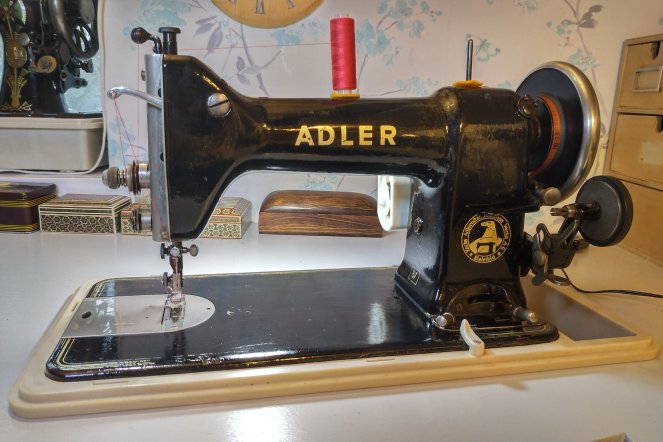
My main sewing machine is a 1930 Adler 87, straight stitch and zig-zag. This machine can handle most materials, from fine to heavy, including jersey with 30% stretch on straight stitch. However, at present I am still using old style needles system 1932A which are no longer being made. I have quite a lot of them, but they only come in regular point. So at the moment I refrain from sewing leather with this machine and I am careful with microfiber jersey as it can sometimes be damaged by regular point needles. In future I shall be converting this machine to modern needles that are available in many different point types, which will increase the range of materials that can be worked with it.
For extra difficult fabrics, or if I fancy using one of the long shuttle machines for their feel and rhythm, I use cylindrical transverse shuttle and vibrating shuttle machines. These machines are my ultimate weapon against uncooperative materials. They never skip stitches and can sew on uneven thicknesses such as when going over a (very) thick seam or when the material is much thicker on one side of the needle than on the other (e.g., when top-stitching) – this is where most other machines require compensating feet.

1914 Bernhard Stoewer’s Serata VS2. Set up for medium to light fabrics at the moment but comes with a second needle plate for heavier fabrics. This is a very fine generic machine capable of sewing pretty much anything out there. It can sew a flexible stitch for jersey, but with a different setting, so I choose not to do it. Currently used for fabrics with up to 20% stretch, both low and high density. Also good for light leather and suede.
This machine works very well with fine needles, something that many machines struggle with when using standard thread. Normally you’re supposed to use extra fine thread with fine needles, but such thread is less common and not always easy to find. In most cases regular thread is good enough for the fine fabric, but not for the fine needles, so you end up using thicker needles and sometimes damaging the fabric. This is why machines that can sew with fine needles and regular thread are so valuable, and Serata is one of them. Adler 87 is the other. 😊

1908 Jones Medium CS “Queen Alexandra”. Set up for heavy duty work – it has great punching power – went through a 1mm thick flat steel bone when I was edging a corset. Never mind sewing leather – we can sew steel! 😯 And yet it can also sew fine cotton lawn with the same setup and the same perfect stitch. I use it for high density materials such as upholstery, denim, tough leather, or for multi-layer garments that need a strong stitch through all the layers, using thick needles and heavy bonded nylon thread.
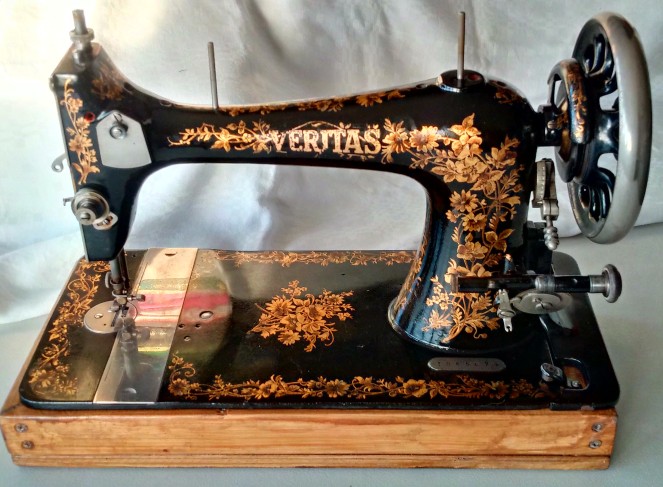
1910 Clemens Müller’s Veritas VS2. Set up for sewing jersey with extra low tension. Gives 40%-50% stretch depending on the fabric.

1902 Singer 48K cylindrical TS. Old style spring-driven feed is exceptionally gentle, so ideal for particularly delicate fabrics such as loosely woven chiffon and finest habitue silk (silk, not polyester), but also great for free hand embroidery and quilting. It gives 60% stretch on the finest jersey, too.
This machine is housed in its old style wooden base because it doesn’t fit into a modern case – it’s a different size. I have two ways of using it in the main area: I can either place it over the machine hole (the wooden base is bigger than the hole), or I can use put it to the left of the main machine, which is what I tend to do, now that I have the room.

1907 Singer 66K, which is a bit of a special 66K. Besides extra wide feed dogs and exceptionally finely tuned mechanism, it also has a most amazing collection of specially made back-clamping feet for unusual embellishment techniques (a post on that is still to come!). And after I fitted a Stoppax darning attachment to it, it is also perfect for free motion embroidery, in particular on thicker materials. However, it is not a fine worker – it tends to tear through delicate fabrics on its current setting. As such, it is a perfect complement to Singer 48K.
The overlockers
The main overlocking station to the right of the main sewing machine can take any of the three overlockers in my possession, as the need arises.

1970s New Home 743 Knitlock by Juki, 4-thread. It just works, a perfect finish every time, without any knob twiddling. It does 3- or 4-thread overlock, that’s it. I haven’t got the accessories for the rolled hem, and resetting tensions for the flatlock is too tedious, so I just stick to overlocking.

2010 or so AEG 760 by Juki, 4-thread. This overlocker is built for fine fabrics and it does a fantastic rolled hem. I use it predominantly with 3 threads because that’s what you use with fine fabrics!

2017 Singer Heavy Duty Ultralock 14HD854 by Juki, 4-thread. This is the modern machine in my collection which I bought new with 10 years warranty. The long warranty is what made me believe it could be of decent quality, and it didn’t disappoint. Apparently the same machines are sold in the USA for half the price and with only 3 months warranty. Well, they may carry the same name but they haven’t got the quality, from what I hear! It seems you always get what you pay for.
This overlocker is of the same basic design as the other two Juki overlockers, but built for medium to really heavy fabrics. It also has all the necessary accessories for doing rolled hems and 2-thread overlock, and makes a brilliant flatlock. A good updated version of a time-proven concept.
The New Home and Singer overlockers have a large overlap in terms of fabrics that they handle, and I mostly use 4-thread overlock on both of them. So why have two overlockers where one (Singer) would have most likely sufficed? Firstly, I’ve had New Home for a long time and Singer is a recent addition, so one of the reasons is historical. 🙂 Experience taught me to never get rid of a high quality machine in perfect working order, so New Home is staying.
The other reason for needing two similar overlockers is the thread. I have fairly recently discovered Coats Moon, which is a lovely inexpensive thread of unexpectedly high quality for the price. It works well both with sewing machines and with overlockers, so this is what I now buy every time I need a new colour. But before that I used to buy plain unbranded polyester thread for overlocking, and I have a drawer full of it in many colours. Although it is not great for sewing, it is perfectly good for overlocking, and I don’t feel justified to just throw it away. But because it is thin and fluffy whereas Coats Moon is thick and smooth, the two thread types require different tension settings. It is not such a drama on a sewing machine, but for an overlocker it takes a lot of knob twiddling, and I am too lazy to do it every time! So I keep New Home on the old thread and Singer on Coats Moon.
The High Chair Space
This is the second area by the window, to the left of the large table.

This cabinet used to house a treadle for Adler 87, but I could not quite fold myself into it. It is a nice cabinet though, with a standard size machine space. So I removed the treadle and use the cabinet as a sewing table. We had to cut down the drop leaf a bit, but there’s still a very decent sewing space to the left. The cabinet is higher than a regular table, and so needs a higher chair to match. This works very well because it allows me to use table top machines on the main table, and have the right height chair for them. This is also my tinkering station!
The main machine here is the most permanently placed one in the whole sewing room because it is installed onto the cabinet hinges and cannot be just lifted out like cased machines. Still, it is not all that much work to switch it for something else if absolutely necessary. So I had to give it some serious thought: which machine gets so much use that it would deserve to be installed permanently?
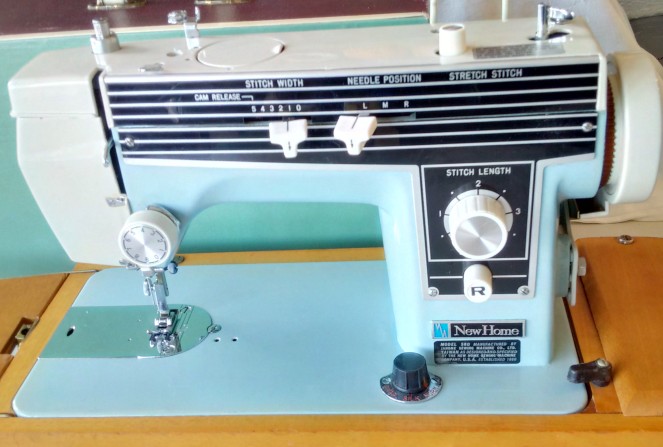
1969 New Home 580 by Janome – straight stitch, zig-zag, back-and-forth straight stitch and triple zig-zag, satin stitch embroidery with cams, and my addition: side-facing twin needle.
Excellent lockable true straight stitch and zig-zag, very stable with the side-facing hook. Delicate feed that can be dropped to half height for fine fabrics and jersey giving 20%-30% stretch in the stitch. Does really nice satin stitch embroidery and comes with 30 cams. Powerful enough to sew heavy wool, yet delicate enough for chiffon. An excellent all-around machine.
This is a machine that doesn’t sound all that great on paper with its old-fashioned mechanism, but it is great in practice. It requires careful adjustment though because these machines seem to have been put together by monkeys, but once you’ve gone through every screw and joint and set it right, they become truly excellent. They give the most stable stitch on the widest range of fabrics.
So why then is this not my main machine? Harp space. Just a little too small for larger projects – a common problem with this type of machine. The proportions come from Singer 15, where the needle-to-column distance was already on the small side. But with the addition of zig-zag and cams, the column and the arm both got thicker, eating at the harp space.
Having the main table on the right is convenient because it allows me to turn it into an overlocking station and create a second complete project space. Of course, I would never have more than one project on the go simultaneously… 😂
The Triangular Space
This is the area with the triangular table for a drop-in machine.
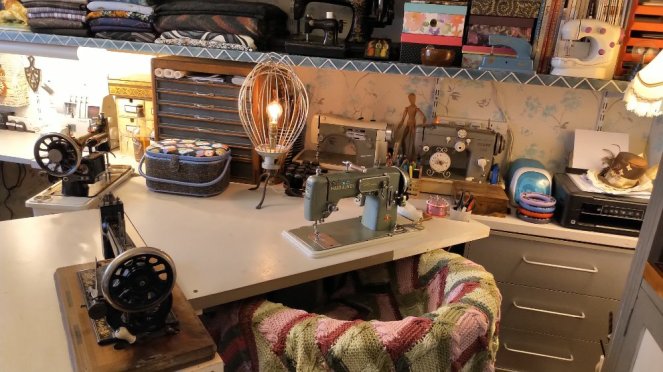
There is a smallish sewing space on the left of the machine but there’s quite a bit of room towards the back, and together it’s a usable space. Besides, if really necessary, I can clear the treadle top at the left for more room.

1950s Haid & Neu Primatic – straight stitch, zig-zag, fancy stitches with cams.
This is one of my absolutely favourite machines (a grade above plain favourite or – a grade below that – really nice machines). It sews all sorts of fabrics beautifully, from fine to thick and heavy, but not jersey (the stitch is not flexible). It sews with double needle without pulling together the stitches. It can disengage zig-zag for a true straight stitch. It can make underbraided corded tucks, delicate rolled hems, fantastic manual buttonholes and can be converted to chain stitch with my addition. I have twelve cams with utility and embroidery stitches, so this machine covers most of my needs that go beyond straight stitch and overlock. Compared to New Home 580, Primatic has two important utility stitches that the 580 can’t do: stitched zig-zag and random zig-zag. Stitched zig-zag is also known as the elastic stitch because it is typically used to stitch on elastic. Random zig-zag is excellent for faggoting flat seams, in particular on tweed or patterned fabric where this stitch completely vanishes into the background.
The Primatic is in fact an excellent complement to the 580, which is why it is the primary machine for the third sewing space.

1955 Pfaff 230 Automatic – straight stitch, zig-zag, built-in fancy stitches.
This is the latest addition to my sewing room, and I haven’t used it in real projects yet. It has a good harp space and a good selection of fancy stitches which can be elongated – great for fine satin stitch. There are no utility stitches though.
This machine seems capable of sewing jersey with a (somewhat) flexible seam, but I haven’t tested it extensively on other difficult fabrics.
So why is this old Pfaff listed here together with Primatic and not further down with the other specialised embroidery machines? Hmmm, not sure. On the face of it, it should be classed as a specialised embroidery, but my gut tells me there’s more to it than just embroidery. Time will tell.
The Free Arm Table
This is one of the temporary sewing spaces: a foldable table for free arm machines.
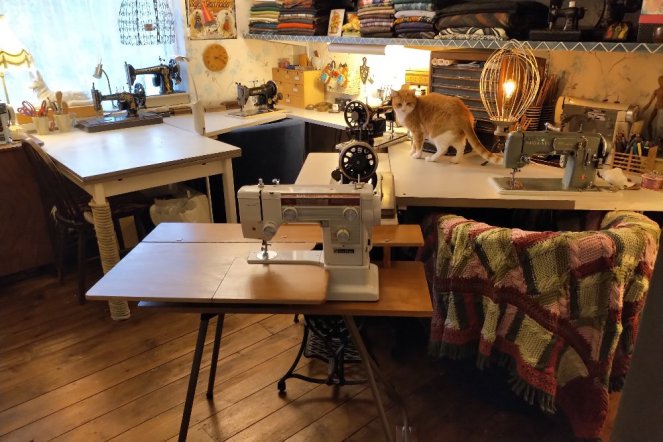
As you can see, the room does get rather full with this table set up, so I don’t keep it here permanently.

1960s Lada T132 (a.k.a. Sewmaster) – free arm straight stitch, zig-zag and fancy stitches with cams.
This is my main free arm machine and a really nice machine for fine to medium fabrics. It is gentle, yet has an excellent grip and is very good with slinky and slippery stuff, as well as foiled, impregnated and otherwise sticky materials. It is good with fine needles and doesn’t always require special fine thread with them. Excellent with lurex and other fragile embroidery threads. It has true straight stitch with a special locking straight stitch cam, and a large selection of fancy stitches with Singer flat Fashion Disks, as wel as its own – it is the same cam type.
This machine has a high torque from the motor, which means that it is very good with dense materials, as long as they are not too thick. Not quite saddle leather, but it’s excellent on several layers of denim or on lamb leather – and not just for straight stitch, but also for embroidery.
There is an extension table that would make it into a flat bed machine, were it not for the very high rise from the table top – 10cm. This makes for uncomfortable sewing. But this is what makes it into a really useful free arm! Luckily I found this special sewing table. 😁

1970s New Home 609 by Janome – straight stitch, zig-zag, back-and-forth stretch stitch and triple zig-zag, chain stitch, built-in utility and embroidery stitches.
This is my second free arm machine, and it too has a good arm which makes it for uncomfortable sewing with the extension table. But it too fits into my table for free arm machines!
This is mostly a utility machine. It has excellent useful stitches, so typical of Janome – they really put thought into their stitch pattern design. Zig-zag is fully disengaged for true straight stitch, and needle is centered independently of zig-zag or fancy stitches. Stretch stitch can be applied on every pattern, and can be adjusted.
Chain stitch on this machine is done with a special adapter, and the result is far better than on Singer or on Jaguar. Janome chain stitch is properly tensioned, the conversion is easy, and when stitches are skipped, the chain is not interrupted, you just get one long stitch instead of two short ones. Since chain stitch unravels easily, this is of crucial importance! This is almost as good as a dedicated chain stitch machine.
Specialised fancy stitch machines
Well, they were all meant as general purpose sewing machines with fancy stitches, but I find their harp space too small for most sewing tasks. However, they have some very interesting and useful fancy stitches, so rather than trying to find a machine that could do it all and have a large harp space without taking up half of the room, I decided to keep a few specialised machines that I particularly liked. They have different fancy stitch mechanisms with unusual possibilities. Unusual in modern machines, that is. 🙂

1955 Necchi Supernova – straight stitch, zig-zag, complex embroidery with 3-tiered cams, side-facing twin needle.
This is a heavy duty embroidery machine – the project book suggests you embroider your shoes and handbags to match your dresses. 🤩 It is smooth and powerful, and works well on all fabrics of substance – but not on satin, chiffon or jersey. However, it is excellent for dense but lightweight fabrics like Oxford weave shirting. It also works well on jackets, coats and quits. The patterns mainly use short stitches with high density, so loose woven or fine fabrics easily become stretched out. Some patterns can be set to use longer stitches, but they are fairly few.
The Supernova can do half a million different patterns by combining the cams and varying machine settings, but none of them are proper utility stitches. Necchi brought out separate utility cams later to cover this shortage, but the stitches are nowhere as good as those made by traditional machines, and having to switch direction so frequently does not agree with the machine (loud banging is not a good sign!). So I don’t force it and use as intended – with original cams with smooth movement. Luckily, I have a few other machines for the utility stitches. 😉

1963 Vigorelli Fantasy – straight stitch, zig-zag, up to 17mm wide embroidery with large “wheel” cams.
The maddest embroidery machine ever! 😃 It moves the entire central section left and right to produce that wide embroidery ribbon, while the needle can do its own zig-zag movement. Impressive! Oh yeah, the feed moves back and forth too. 🙂
Contrary to Necchi Supernova, Vigorelli Fantasy is a fine worker. It has nylon gears, so I would not use it on tough materials. But on the plus side, it has massive feed dogs and equally massive feet which, combined with rather low foot pressure, enables it to embroider fine and slippery materials – with only a minimal shift in the pattern. Fantastic for embroidering jersey!
But like the Supernova, it doesn’t do utility stitches, although straight stitch and zig-zag is very nice indeed, also on difficult fabrics.

1986 New Home Memory Craft 6000 by Janome – straight stitch, 7mm wide zig-zag, utility and embroidery stitches.
This is a computerised machine with two alphabets, three types of buttonholes and many lovely stitches. It has manual controls too, making it even more interesting. Oh, and there is a free arm, although it is not really free enough for serious use.
This is another one of those machines that looks pretty modest on paper but proves to be really great in practice. It has very useful stitches, very well thought through. I would call it “long stitch embroidery” because most patterns are made up of long sideways stitches rather than of short sequential ones – perfect for fine fabrics and jersey. It is in many ways the opposite of Supernova. This machine also has special stitches for free hand silk shading – wow! And it can handle a good range of fabrics, too. A typical New Home. 🙂

1990s Pfaff Creative 7510 – straight stitch, 9mm wide zig-zag, utility and embroidery stitches.
In many ways this Pfaff feels like an upgraded Memory Craft – it has more utility stitches and buttonholes, a better way to combine letters and patterns, and more intricate decorative stitches. It also has Pfaff IDT which is an added needle feed but not quite a walking foot, and a wider zig-zag. It’s a great machine, and buttonholes are unsurpassed thanks to a special underfeed attachment.
So why am I keeping the old Memory Craft as well? Stitches and fabrics. As similar as the two machines appear at the first glance, their stitches are different and the way they treat fabric differs radically. Memory Craft has a rather gentle feed, which means that the pattern may slip if the fabric shifts or stretches easily. But with a long stitch pattern, it can handle delicate, loose woven and knitted fabrics, and it’s great for free hand work.
Pfaff on the other hand has a strong feed, with or without IDT. This prevents the patterns from slipping but it is too rough for delicate or stretchy materials. I have so far not been able to use embroidery or even utility stitches on fine fabrics without them getting chewed up and pulled into the bobbin case. 😦 But give it a thick edging to embroider, and Pfaff is your best friend! It is also excellent for dense fabrics, thick or thin, and even for leather, if you dare (mind those resin gears!!).
The Fabric Store
Now that we have a puppy, the first shelf also doubles as safe cat sleeping quarters. 😁

I suppose I should keep my fabric stash in check now! 😮
My heartbeat goes faster and faster as I scroll through your beautiful machines. Your new room is to die for. Great job on the layout. The cat refuge is the icing on the cake!
LikeLiked by 1 person
Thank you! 😀 I admit I enjoy it very much! Although it did take me two days to tidy it up for the photos! 😮
LikeLiked by 1 person
I can identify with the tidying up challenges in the sewing area!
LikeLike
Loved reading about the attributes your various machines. I hope I can be that organized someday. My unexpected favorite vintage machine is my Bernina 801 sport. After I started using it, all of my other sewing machines (new or old, industrial or household) pale in comparison.
LikeLike
It is funny how treasure usually hides under an unassuming appearance! 😀
LikeLike
what a wonderful room and what a wonderful post! Cat looks like a happy gnome up on that shelf.
LikeLike
Yes, but have you spotted the second cat on that shelf? 😀
LikeLiked by 1 person
I see it now! 😀 😀 I’ve long wondered how compatible is a sewing room with cats. Do they knock things over? Do you have to take some precautions like never leaving boxes with small objects open and the like? 🙂
LikeLike
It all depends on the cat. Cats are very graceful in their movements naturally, so they quickly learn to navigate the shelves without knocking anything over accidentally. Of course, if they decide that something is in the way, they’ll knock it over deliberately. 😮 But generally if you have a good relationship with your cats, they don’t cause any damage. But they do like to play, especially when they are young, so leaving small round objects out like thread spools or bobbins may not be a good idea – they will roll away and the cats will be compelled to follow… But generally I don’t do anything special to keep things in place – the cats leave them alone, most of the time. 😉
LikeLike
Oh what beautiful machines and such an inviting work area. Your feline friends look like they’ve each found good positions for supervising your activity. I love reading the reason you selected each machine- their strengths and weaknesses.
LikeLike
Thank you! A lot of those reasons were revealed through sewing – I couldn’t figure them out from any write-ups!
LikeLiked by 1 person
Wonderful eye candy! I love that the Vigorelli sounds like it does the Cha-Cha! Some amazing machines and the set up is brilliant to make use of them all. One day I tell myself! And of course the cat! One day for that and a dog too! LOL! Thanks for the tour Elena – did enjoy.
LikeLike
I am happy that my tidying efforts paid off! It’s never that empty in real life! 😉 Have you spotted both cats in the last photo? The Ninja is quite sneaky, you know.
LikeLike
😂 Those ears! No, I didn’t – but Ninja is the perfect name!
LikeLike
Her first name is Bops (short for Boudica), but her middle name is Ninja. Ambush and sharp attack is her style – gets Tom every time, even though he’s supposed to know this classic tactic! So by now he checks every shady corner, just to be sure. Roxy the puppy has also discovered the power of a cat’s swipe from the dark on that large canine nose. 😯 Which doesn’t discourage Roxy in any way to chase the Ninja into another dark corner, even though that inevitably results in another swipe… What can I say – we’re having fun! I even manage to get some sewing done in between…
LikeLike
Well done – so many fun distractions!
LikeLike
Your machines are so beautiful! 😍 What a great sewing room tour.
And now I need to look up coats moon thread. My old favorite isn’t being made anymore.
LikeLike
Thank you elena for your fantastic blog.
As now, you had more time to use it, could you tell us a little bit more about your experience with the pfaff 230.
After reading you blog, I had the feeling you had some doubts about its capacities and versatility.
As I’m refitting one your feed-back would be very appreciated
Regards
LikeLike
Hi Lauren, thank you for your kind words! 🙂 I must admit, I expected I would use Pfaff 230 more. It is working fine, so that’s not a problem. It has a powerful motor, good punching power and feed, it is also pretty good on fine fabrics, and will be better with use, no doubt. These are all plusses, and yet… The need to flip back the machine to change the bobbin is a real plain. The machine is too heavy for it, it falls back smashing into the wall behind it because my wrists are too weak to hold it and there is no support for it. And if I don’t let go of the machine, how am I to change the bobbin with one hand?
The second issue is the lack of utility stitches. In my everyday sewing I often need them, and all this machine has to offer is plain zig-zag. Embroidery is nice but is no substitute for utility stitches.
The result is that even if I forgo utility stitches, there are not enough advantages in Pfaff 230 to make me choose it over one of my other machines.
LikeLike
Elena.
Thank you so much for your feed back.
I perfectly understand that the change of the bobbin is a real pain in the neck and i feel lucky to have my 230 on a cabinet.
Just to know, what’s the utility stitch you use the most often ?
Regards
LikeLike
There are several, depending on the project. So in no particular order: stitched zig-zag, blind hem with zig-zag, randomised zig-zag, and straight stitch with occasional overedging. These are all stitches without reverse movement. The first three are common, the last one less so. I also use stitch and overcast with modified reverse movement as found on some machines that allow to regulate the amount of reverse in their stitches.
Regarding the change of bobbin in Pfaff 230, I had mine in a cabinet too. Still too heavy – I have weakened wrists due to carpal tunnel issues.
LikeLike
Thank you for sharing your interesting thoughts about your crew of sewing machines. Four of you machines are long shuttle machines.
Did you have an issue on getting extra long bobbins for them?
I have seen, that Helen Howes have listed some of them. I made a short list of the dimensions I got here: https://drive.google.com/uc?id=1qKhT8faC0Zqxk8QwRCuqayPznHITKEZZ
LikeLike
I buy reproduction VS bobbins with the little hole in the cap. No issues. I also have a large collection of vintage VS bobbins of different makes, again no issues, except that Singer bobbins have no hole in the cap and so don’t work with bobbin winders on other makes. TS bobbins are a whole different story however, they are very specific to their own makes and models.
LikeLike